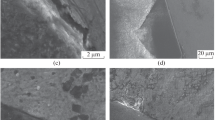Abstract
High-temperature oxidation of diamond powder and that coated with Ni-P has been studied by differential thermal analysis. It is shown that the temperature for active oxidation of uncoated powder is 820°C and that for composite powder is higher by 100°C. According to the thermogravimetric and DTA curves two kinds of chemical reaction are found for weight loss, i.e. with CO formation at the specimen surface (low-temperature TG curve parabolic region) and CO2 formation (high-temperature linear region). A catalytic effect of nickel on CO formation is established.
Similar content being viewed by others
References
V. G. Chuprina, I. M. Shalya, and V. P. Umanskii, “Oxidation of Cr-Ni coatings on diamond,” Poroshk. Metal., No. 7, 62–67 (1993).
Yu. V. Naidich, G. A. Kolesnichenko, I. A. Lavrinenko, and Ya. Yu. Matsak, Soldering and Metallizing of Superhard Tool Materials [in Russian]
N. S. Zyukin, Yu. V. Naidich, and G. A. Kolesnichenko, “Study of the wetting of polycrystalline diamond materials by some molten metals,” Adgeziya Rasplavov i Paika Materialov, No. 7, 51–54 (1981).
I. N. Gorbatov, A. D. Panasyuk, L. K. Shvedova, et al., “Sprayed coatings of composite powders based on titanium-chromium carbide,” in: Protective Coatings on Metals, No. 25 [in Russian], Institute of Materials Science Problems, Ukrainian Academy of Sciences, Kiev (1991).
A. D. Panasyuk, V. N. Klimenko, V. G. Kayuk, et al., “Study of the interphase reaction m the system chromium carbide-nickel alloy,” Adgeziya Rasplavov i Paika Materialov, No. 19, 63–68 (1987).
V. A. Lavrenko, A. P. Pamytkin, V. S. Neshpor, and F. L. Vinokur, “High-temperature reaction with oxygen for ‘anisotropic’ pyrolytic graphite,” Izv. Akad. Nauk SSSR, Neorgan. Mater., No. 5, 873–877 (1980).
R. F. Voitovich and É. I. Golovko, High-Temperature Oxidation of Metals and Alloys: Handbook [in Russian], Naukova Dumka, Kiev (1980).
N. Cabrera, “Occurrence of etching pits and oxidation centers at dislocations,” in: Elementary Processes of Crystal Growth [Russian translation], NIL, Moscow (1959).
N. N. Tikomirova, M. I. Markin, I. V. Nikolaeva, and V. I. Voivodskii, “Study of the reaction of molecular oxygen with free valency coal,” in: Physics and Physical Chemistry of Catalysis [in Russian], Izd. Akad. Nauk SSSR, Moscow (1960).
V. A. Lavrenko, V. S. Zenkov, O. A. Panasyuk, et al., “Reduction of a mixture of oxides for permalloy alloys,” Zh. Prikl. Khim., No. 4, 736–739 (1977).
Additional information
Institute of Materials Science Problems, Ukrainian National Academy of Sciences, Kiev. Translated from Poroshkovaya Metallurgiya, Nos. 1/2(383), pp. 55–58, January–February, 1996. Original article submitted April 15, 1994.
Rights and permissions
About this article
Cite this article
Lavrenko, V.A., Podchernyaeva, I.A., Peikhua, K. et al. Effect of cladding diamond powder with a nickel-phosphorus alloy on its high-temperature oxidation. Powder Metall Met Ceram 35, 48–51 (1996). https://doi.org/10.1007/BF01512662
Issue Date:
DOI: https://doi.org/10.1007/BF01512662



